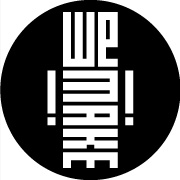#WeMakeStories: EJTech tra elettronica tessile e Blade Runner
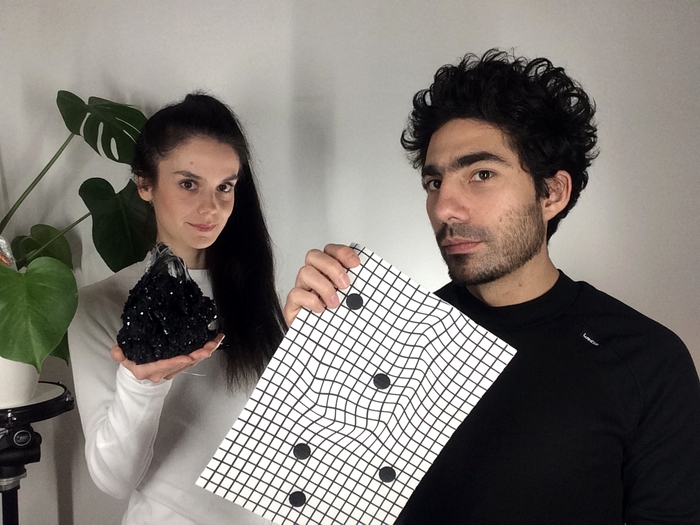
English below
EJTech è un duo messico-ungherese e il loro nome è deriva delle iniziali dei loro nomi, Esteban e Judit (Esteban De La Torre e Judit Eszter Kárpáti).
EJTech un laboratorio di arte e tecnologia sperimentale con sede a Budapest e che per la seconda volta in due anni sono ospitati a WeMkae. In questi giorni Esteban e Judit stanno svolgendo una Maker In Residence per portare avanti un progetto di ricerca focalizzato su speaker audio tessili e noi abbiamo approfittato della loro presenza per intervistarli!
Come vi siete incontrati?
J: Ci siamo incontrati all’Università di Budapest, il MOME, ho studiato design tessile e Esteban ha studiato animazione. Dopo l’università abbiamo iniziato a lavorare grazie a una borsa di studio a Kitchen Budapest ed è qui che abbiamo iniziato a sperimentare nel campo dell’electronic textile e della tecnologia wearable.
E: Direi che abbiamo iniziato a lavorare con l’arte interattiva. Prima di lavorare con Judit, mi occupavo principalmente di progetti che riguardavano il suono cercando di creare installazioni sonore reattive, installazioni audiovisive, nel campo dell’arte interattiva. Judit mi ha mostrato il suo lavoro, Chromosonic, ed è stato molto interessante vedere un tessuto che cambia colore con la musica. Me l’ha mostrato quando ha finito il suo master e ho avuto l’opportunità di lavorare con lei.
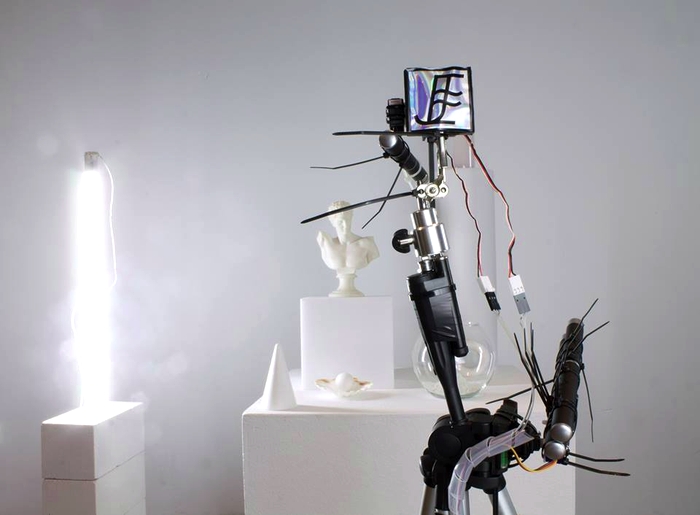
In che anno siamo?
E: 2013. Cinque anni fa. È stata lei a mostrarmi questo genere di cose, come i circuiti morbidi, a farmi pensare al tessile come qualcosa di più della semplice moda, come un mezzo per fare altro. Abbiamo così iniziato a collaborare. Se vedi i nostri progetti, non abbiamo mai lavorato veramente con i wearable, direi cha abbiamo sempre usato il tessile come un mezzo, come i pastelli, i colori all’olio o le sculture in bronzo.
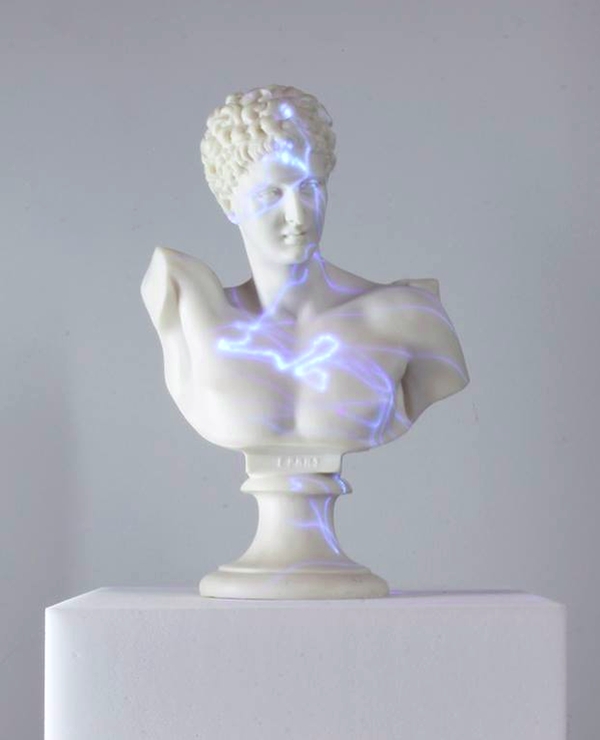
Riuscite a vivere con EJTech?
E: Sì. EJTech è tre cose: fondamentalmente la ricerca e la pratica artistica, l’opera d’arte, la mostra, la performance, per questo abbiamo creato EJTech; poi abbiamo la seconda cosa, cioè il lavoro delle commissioni di film, teatri, architetti, dove raccogliamo la maggior parte degli introiti; infine, teniamo workshop, corsi, lezioni sulle arti interattive, i tessuti intelligenti etc. Penso che oggi ci sia un grande movimento nel mondo sull’arte e la tecnologia, come riuscire a mettere insieme arte e scienza. È qualcosa che sta accadendo da un po ‘di tempo, ma sta diventando sempre più importante.
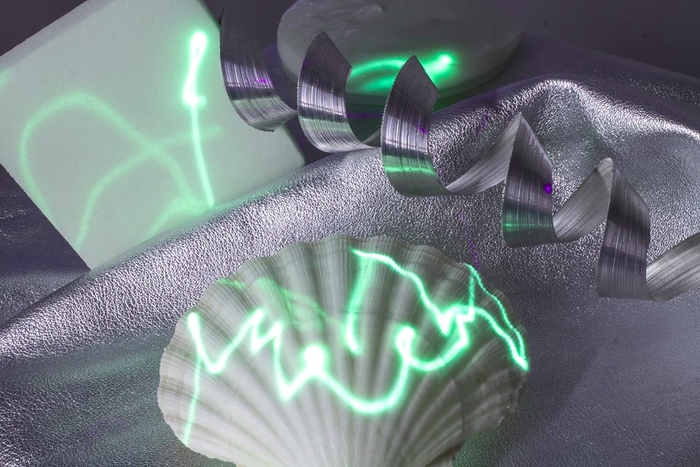
Qual è uno degli ultimi vostri lavori per clienti importanti?
E: Adesso stiamo lavorando per il film Terminator 6.
J: È girato in Ungheria…
E: È un po’ confidenziale… ci sono parti di armamento per i militari e stiamo facendo le luci e gli oggetti di scena e i costumi.
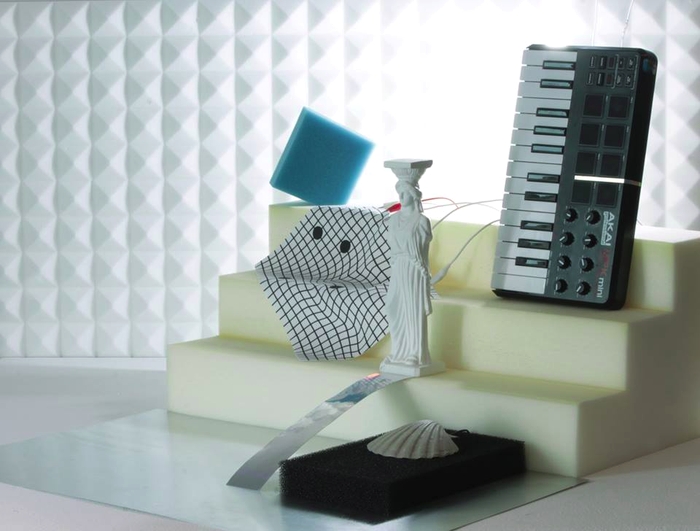
E per Blade Runner 2049 cosa avete fatto?
E: Ero nel reparto costumi, mi sono occupato di circuiti morbidi e luci incorporate nei personaggi. Blade Runner è ambientato nel futuro, ed è sempre buio, bagnato e piovoso, quindi gli umani hanno bisogno di emanare una luce propria quando camminano, un po’ come le biciclette per strada di notte. Durante gli incontri di preparazione è emerso che l’effetto da rendere era simile a quello che si vede nei pesci che vivono nell’oceano profondo, da qui abbiamo pensato a dei costumi che emanassero luce propria. Se guardi i pesci sul fondo dell’oceano non hanno melanina o altro, quindi sono traslucidi e puoi vedere i loro organi all’interno dei loro corpi che sono bio-luminosi. Questa è stata l’ispirazione e per cinque mesi abbiamo lavorato alla produzione. Judit mi stava aiutando, ma io ero quello in studio tutto il tempo.
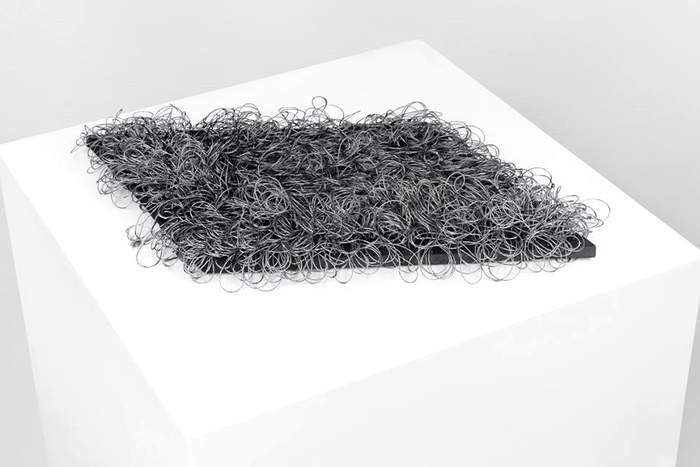
Come siete arrivati a WeMake? Questa non è la prima volta.
J: La prima volta è stata due anni fa. Ho ottenuto una borsa di studio dallo Stato ungherese.
Perché siete venuti a WeMake?
E: Abbiamo incontrato Zoe in Francia, 3 anni fa, durante il campo estivo di e-textile. Ci sono pochi makerspace che lavorano col tessile! Non avevamo mai usato una lasercutter prima e lei ci ha mostrato come fare e soprattutto come farlo con i tessuti. In altri makerspace si lavora di più con plexi, legno e altri materiali. Questo tessuto elettrico o smart textile è una piccola area molto specializzata non molto conosciuta.
J: A quel tempo in Ungheria non c’erano ancora i makerspace.
E: È stato bello e siamo stati qui per 2-3 mesi la prima volta.
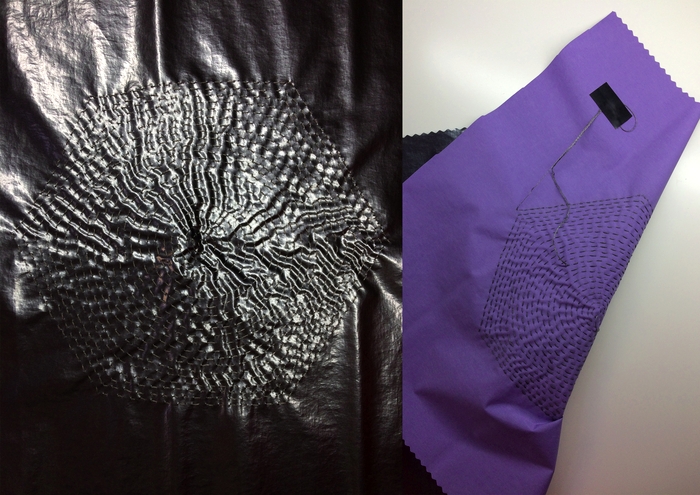
Qual era il progetto?
E: Gli speaker tessili.
J: Abbiamo anche tenuto un workshop sugli altoparlanti e i sensori e sperimentato con un robot Kuka. Quest’ultima è stata una collaborazione con i Caracol che vivevano al piano di sopra (ndr Caracol lavorava con WeMake al progetto Robotrip).
E: Avevamo il nostro laser, il braccio del robot disegnava con una macchina fotografica puntata su ciò che stava disegnando producendo allo stesso tempo un suono. Quindi abbiamo creato una sorta di “maestro d’orchestra” che produceva una specie di modello su un tessuto basato sulla Rodonea, una curva algebrica il cui grafico è caratterizzato da una serie di avvolgimenti attorno ad un punto centrale, tali avvolgimenti producono figure a forma di rosone o fiori.
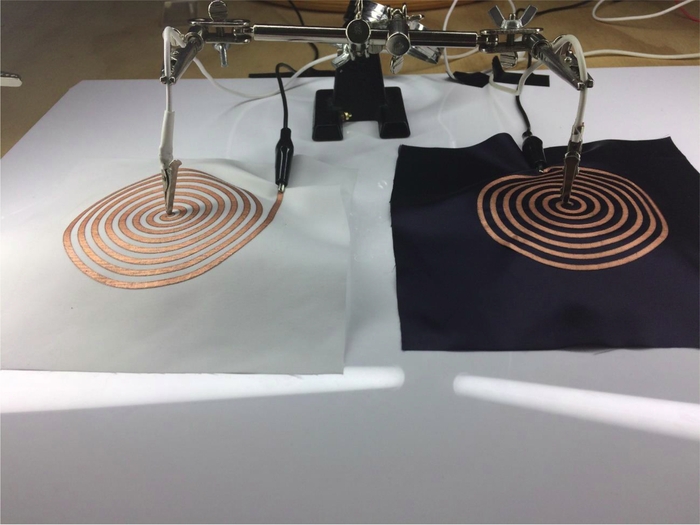
Quando siete arrivati nel 2016, come vi è sembrato WeMake?
E: È stata una bella impressione… lavorare con le macchine non è una cosa che puoi fare quotidianamente di solito e quindi quando siamo arrivati in un posto con così tante macchine e con così tante persone a cui chiedere informazioni, siamo rimasti molto colpiti. Abbiamo potuto sperimentare tutto, provare a fare cose, abbiamo fatto errori, abbiamo riprovato …
Questa è l’idea del progetto della Maker in Residence!
E: Quando lavori su un progetto in residenza hai la possibilità di focalizzarti su quello, ti viene in mente qualcosa e non devi aspettare per poter sperimentare. Potevamo uscire, pensare alle cose mentre stavamo mangiando, tornare qui e provare. Quando siamo arrivati qui l’amplificatore per lo speaker era molto grande; quando siamo partiti stavamo usando un amplificatore molto più piccolo. In due mesi abbiamo potuto progredire molto. È stato bello aver avuto la possibilità di stare qui.
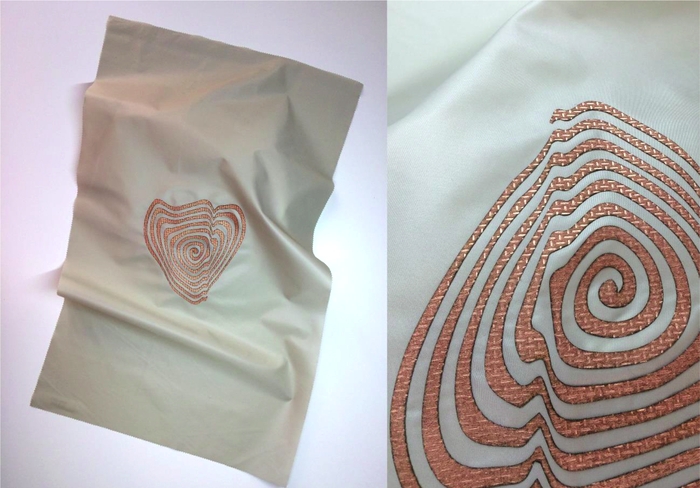
Nel 2018 siete tornati a WeMake. Cosa state facendo?
E: Stiamo lavorando al progetto Paramatrix. Zoe ha fatto una application per il Worth Project finanziato dall’UE per lavorare su una matrice tessile per la fabbricazione digitale.
J: Ci ha chiesto di collaborare con lei perché il progetto richiedeva una partnership internazionale a seguito dell’ottenimento del finanziamento.
E: Stiamo lavorando su una matrice di sensori intrecciati leggibili digitalmente. Non è così semplice lavorare su sensori digitali tessili, perché non sono stabili. Abbiamo molta esperienza con i sensori tessili e contribuiamo anche da un punto di vista estetico. Penso che a Zoe piaccia anche la nostra estetica. In questo progetto non ci siamo occupati della parte tessile, lo sta facendo una tessitrice professionista italiana, Nicoletta Di Gaetano, coinvolta da WeMake insieme a Giorgia Petri che si occupa invece della parte elettronica.
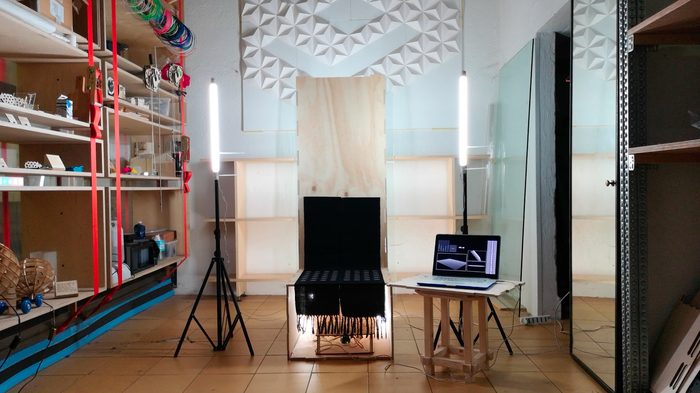
Nicoletta ha tessuto la matrice tessile, quando siamo stati qui in estate abbiamo avuto quattro giorni di brainstorming sul tessile, diversi tipi di pattern di tessitura e maglieria, perché dovevamo risolvere un problema: abbiamo bisogno di un sensore di pressione che dà una lettura quando ci si siede, ma quando ci si alza il valore non torna subito a zero, e questo è un problema che stiamo cercando di risolvere. È come quando si va al supermercato, si pesano le proprie mele e quando si tolgono il bilanciere non torna subito a zero e quindi la persona seguente che pesa le mele registra un valore maggiore rispetto a quello effettivo dei suoi prodotti. Non va bene! Stavamo lavorando su come riportare i sensori sullo zero e l’abbiamo fatto funzionare. In questo momento quello che stiamo facendo è la parte fisica, cioè come collegare i tessuti della sedia e tutti i cavi digitalmente. Abbiamo 48 diversi sensori e tutti devono essere collegati ad Arduino. Se hai solo 2 sensori, hai 2 cavi ed è tutto a posto. Ma con questa quantità di sensori è necessario trovare altre soluzioni. Stiamo cercando di farli diventare dei jack per collegarli. Dobbiamo fare una sorta di collegamento tra tessile e digitale.
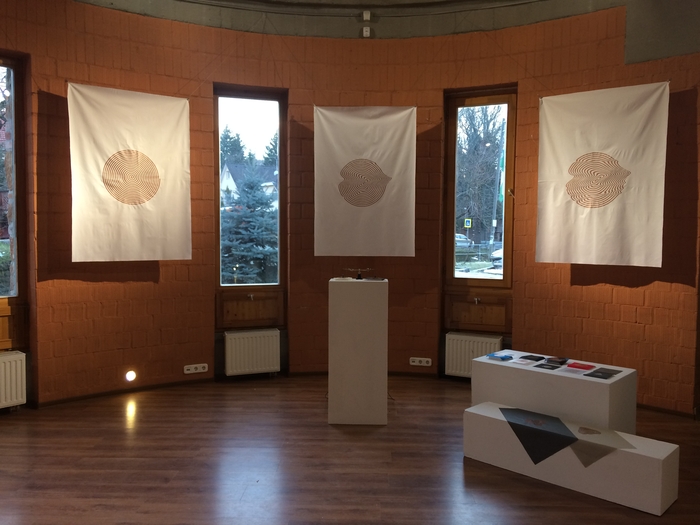
Qual è l’altro progetto a cui state lavorando qui?
J: Il mio dottorato. Sarà un’installazione di speaker tessili. Usiamo la lasercutter per creare il modello degli altoparlanti in diverse dimensioni, al momento stiamo facendo dei test per trovare quelli migliori. Spero di poter finire in 2 settimane. Stiamo facendo progressi ed è la fine del progetto che abbiamo iniziato nel 2016. Ora la dimensione del progetto è molto più grande!
E: Due anni fa è stata una ricerca, ora ci stiamo avvicinando al punto in cui abbiamo un prodotto reale.
J: Abbiamo tagliato gli speaker tessili con il laser e lo facciamo vibrare per produrre suoni.
E: Fondamentalmente il suono è qualcosa che colpisce l’aria, quindi se colpisci molto velocemente con la mano puoi produrre suoni e ascoltarli.
J: È l’opposto del progetto tessile. Usiamo il tessile come output e non come input.
E: È come un display audio. È possibile visualizzare vari tipi di informazioni. Non è solo modulare, ma hai speaker identificati. Ogni speaker può rappresentare un insieme di dati. Se disponi di 32 speaker, ciascuno rappresenta un insieme di dati. Puoi avere una schiera di 32 cavalli e ogni cavallo ha la sua velocità collegata a uno speaker, e puoi sentire ogni cavallo individualmente secondo ciascuno speaker. È davvero interessante creare paesaggi sonori. È un modo interessante di lavorare con il suono dove il materiale è davvero importante.
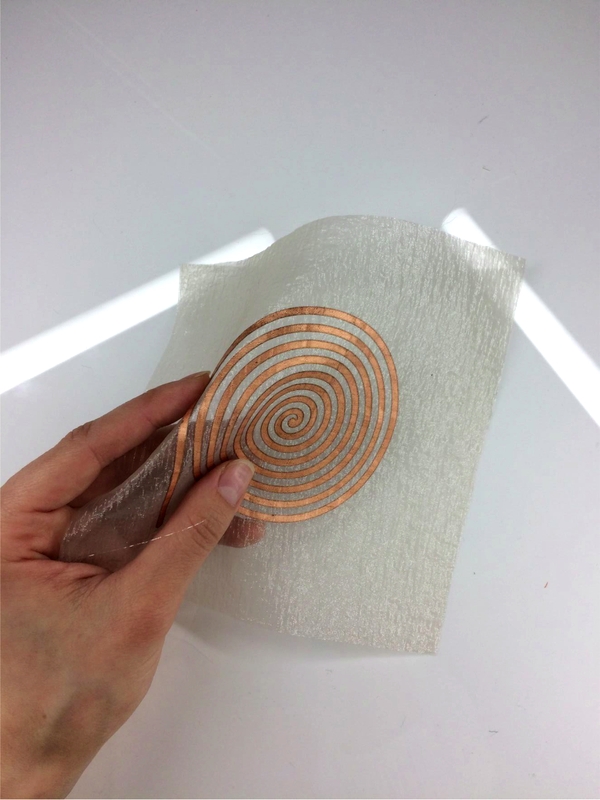
In generale, il vostro lavoro è rilasciato con licenza open source o usate licenze proprietarie?
J: Dipende dal tipo di progetto e dal tipo di cliente.
E: Abbiamo spesso clausole di riservatezza.
J: Ma durante i workshop condividiamo tutto ciò che produciamo e lo spieghiamo…
E: È un modo per restituire: grazie a Internet abbiamo imparato molte delle cose che sappiamo, come l’uso di un bluetooth o altro. Per noi è un modo di restituire alla comunità ciò che abbiamo ricevuto.
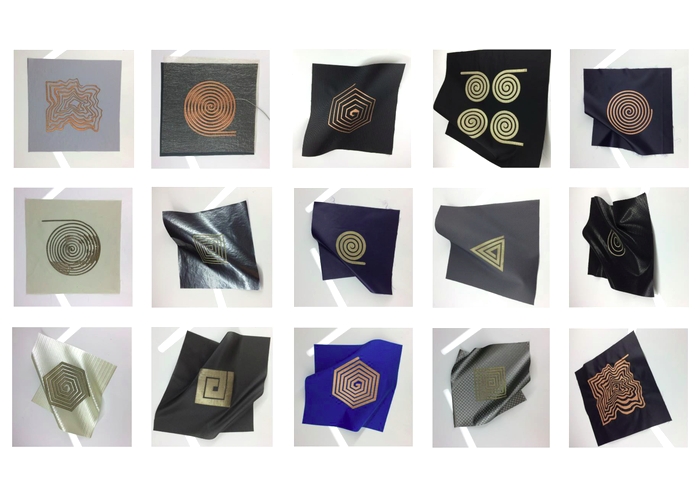
Avete pubblicato qualche tutorial online?
E: Sul sito di WeMake si possono trovare un paio di tutorial e abbiamo appena creato un profilo su Wikifactory con alcuni tutorial su cui abbiamo lavorato, come uno su sensori serigrafati. Lavoriamo molto con colori conduttivi, quindi abbiamo condiviso alcune informazioni su come sia possibile stampare i sensori in serigrafia. Adoro la serigrafia e ci abbiamo lavorato per interfacciare schermi e musica.
EJTech: Esteban De La Torre and Judit Eszter Kárpáti
vimeo – instagram – facebook – tumbrl
——————
Who is EJTech?
J: It’s an hungarian-mexican duo. EJTech is from our names Esteban and Judit.
How did you meet?
J: We met at the University in Budapest, the MOME, I studied textile design and Esteban studied animation. After the University we started to work in a scholarship program in Kitchen Budapest and that’s where we first started to work in electronic textile and wearable technology.
E: I would say we started to work with interactive art. Before working with Judit I was working a lot with sound and trying to work sound reactive installations, audio-visual installations, like the more mainstream of interactive art. Judit showed me her work, Chromosonic, and it was super interesting to see a textile which changes color with music. She showed it to me when she finished her master and I got the chance to work with her.
When was it?
E: 2013. Five years ago. She was the one showing me this kind of things, like soft circuitry, to think about textile as something more than just fashion but more as a beautiful medium. We started to work together. If you see our work we’ve never really worked with wearables, but more with textile as a medium, something like pastel or oil or sculptures in bronze.
Do you make a living out of EJTech?
E: Yes. EJtech is three things: basically the artistic research and practice, artwork, exhibition, performance, that’s the reason we created EJtech; then we have the second thing, commission work, where we get most of our money. We have commission from movies, theaters, architect; then we give workshop, courses, lessons about interactive arts, smart textiles, these things. I think there’s a big movement in the art world about art and tech, like art and science put together. It’s something that’s been happening for some time but it’s becoming big now.
So, now one of your last works for clients?
E: One right now is for Terminator 6.
J: It’s been filmed in Hungary…
E: It’s a bit confidential… there are arm piece for the military and we are making the lights and props and costumes for it.
And for Blade Runner 2049?
E: I was in the costume department and it was soft circuitry and embedded lighting. Blade Runner is set in the future, and it’s always dark and wet and rainy, so humans need to have their own lights when they walk, like bikes on the street at night. During the meetings the idea was like the fishes in the deep ocean, you know fish need their own like, so we thought of costumes with their own light. If you look at fishes on the bottom of the ocean they have no melanin or whatever so they are translucent and you can see their organs inside the bodies that are bio-luminous. That was the inspiration and for five months we were working on the production. Judit was helping me, but I was the one in the studio all the time. It was more like we would propose something for the costume, but for the movie and especially for Blade Runner they had a really static script and time composition, we could propose something, if they liked it we moved on otherwise not.
How did you arrive in WeMake? This is not the first time.
J: The first time was 2 years ago. I got the scholarship from the Hungarian State.
Why did you come to WeMake?
E: We met Zoe in France, 3 years ago, during e-textile summer camp. There are few makerspaces working with textiles as well so it’s important. We never used a laser cutter before and she showed how to use it, she has the experience on how to use it with textile. Other makerspace are more on plexi, wood, and other materials. This electric textiles or smart textiles is a very specialised little area not so many people know about.
J: At that time in Hungary there was no maker space yet.
E: It was cool and we were here for 2-3 months the first time.
Which was the project?
E: The textile speakers.
J: We also gave a workshop on the speakers, sensors and experimented with the Kuka robot. This was a collaboration with Caracol which was living upstairs (ndr Working with WeMake on the project Robotrip).
E: We had our laser, the robot arm would draw on the laser and we had a camera on what it would draw and it would create some sound. So it would be a sort of “maestro d’orchestra” and it would create a sort of pattern on the textile based on Rodonea a mathematical function for flowers particularly roses and it would be a performance.
When you arrived in 2016 how did you find this place?
E: It was very cool… working with machine is not so everyday and we arrived in a place with so many machines and with so many people to ask things about. We could experiment with everything, try things, make a mistake, try again…
This is the idea of the residency project.
E: When you work on a project in residency you’re on it all the time, you think of something and you don’t have to wait to experiment it. We could go out, think about things while we ate, come back and try it. When we came here the amp for the speaker was very big; when we left we were using a amp much much smaller. In two months we could advance a lot. It was so good to be here.
You are back to WeMake now. What are you doing now?
E: We are working on the Paramatrix Project, . Zoe applied to receive funds from EU-funded Worth Project to work on a textile matrix for digital fabrication.
J: She asked us to collaborate with them as the project required an international partnership and the project got the funding.
E: We are working on a matrix of woven sensors to be able to make digital readings that are good. It’s not that simple to work on textile digital sensors, because they are not stable. We have a lot of experience with textile sensors and also we contribute to the aesthetics. I think that Zoe likes our aesthetics. We didn’t do the textile, it’s a professional weaver from Italy, Nicoletta Di Gaetano, involved by WeMake together with Giorgia Petri who’s taking care of the electronic part.
Nicoletta wove the textile matrix. When we were here in the summer we had a four days brainstorming on textile, different types of weaving and knitting pattern, because we had this problem, it’s a push sensors that gives you a reading when you sit, but when you stand up it does not go back to 0, and it’s a problem we are trying to solve. It’s like going to the supermarket, weighing your apples and when you take them away it doesn’t go back to 0, so the next person weighing the apples would weigh more. No good. We were working on how to have the sensors go back to 0. And we made it work. Right now what we are doing is the physical part, that is how to have the chair textiles and all the cables into the digital. We have 48 different sensors and they all have to be connected to Arduino. If you just have 2 sensors, you have 2 cables and it’s totally fine. But with this amount of sensors you need to find other solutions. We are trying to make them into jacks to connect them. We have to make a sort of translations between textiles and digital.
Which is the other project you are working on here?
J: It’s my phd. It’s gonna be an installation on textile speakers. So we use the laser cutter to make the pattern of the speakers in different sizes, we are testing it to find the best ones. Hopefully I can finish it in 2 weeks. We are making progress and it’s the end of the project we have been working since 2016. Now the scale of the project is much bigger.
E: 2 years ago was a research, now we are approaching the point where we have an actual product.
J: We cut the textile speakers with the laser and make it vibrate to produce sound.
E: Basically sound is something hitting the air so if you hit really fast with your hand you can produce sound and hear it.
J: It’s the opposite of the textile project. We use textile as output and not input.
E: It’s like an audio display. You can display various type of information. It’s not only modular, but you have designated speakers. Each speaker can represent a set of data. If you have 32 speakers, each speaker represent a set of data. You can have an array of 32 horses and each horse the speed is connected to one speaker, and you can hear each horse individually according to each speaker. It’s like taking a sound system and breaking into grains, different parts. It’s really interesting to create soundscapes. It’s an interesting way to work with sound where material is really important.
Generally speaking your work is released as open source licence or you use proprietary licences?
J: Itl depends on the type of project and on the type of clients.
E: We have often confidentiality clauses.
J: But during the workshop what we produce and explain we share what we know…
E: In a way we want to give back. Many of the things we learnt it was thanks to the internet, like using a bluetooth or other things. There’s a lot of info on the Internet and we want to give back what we used so much.
Have you released any tutorial online?
E: On WeMake website you can find a couple of tutorials and we just created a profile on Wikifactory with some tutorials we have worked on, like one on silkprinted sensors. We used to work a lot on electric paint so we shared some info on how you can screen print your sensors. I love screen print and we worked with it to have screen and music interfaced that are screen printed.
EJTech: Esteban De La Torre and Judit Eszter Kárpáti
vimeo – instagram – facebook – tumbrl
